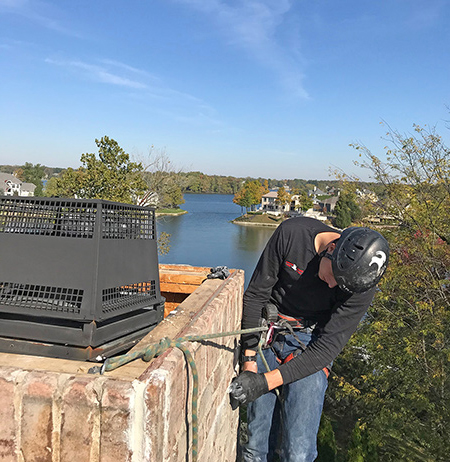According to the Farmer’s Almanac, we can expect that this winter will be cold and snowy here in Colorado. A cold winter means high heating costs. Keeping your wood pile stocked and stoking up a fire in the hearth on chilly nights can help you cut down on heating costs. Chimney problems can throw a wrench in your budget.
Even though chimneys are built to withstand extreme temperatures, they are still affected by the cold. There are two main ways that cold affects chimneys:
 • Breaking Down Bricks and Mortar
• Breaking Down Bricks and MortarBricks and mortar act like sponges; easily absorbing moisture. In the winter, when the temperatures drop, the moisture inside the masonry expands as the water freezes. When the temperature warms up, it contracts as it thaws. This process breaks down the bricks and mortar causing it to crack and chip. The more this happens, the weaker the masonry becomes.
The freezing and thawing process can cause serious and expensive damage. It can also create pathways for carbon monoxide and fire to enter your home increasing the danger of using your fireplace.
Treating the outside of your chimney with waterproof sealant is the best way to protect your chimney from the freezing and thawing cycle.
The “stack effect” is the name of an air pressure problem that can occur during the winter when the air in your home is significantly warmer than the air outside. You might remember learning in school that hot air rises. This is what causes the stack effect.
All the hot, heated air in your home moves upward, increasing the air pressure upstairs and seriously reducing the air pressure downstairs. When this happens, it reverses the airflow in your home. It can suck cold air down the chimney.
Unpleasant blasts of cold air aren’t the only downfalls of the stack effect. This air pressure problem can also make it more risky to light a fire in your fireplace. When airflow is reversed by the stack effect, carbon monoxide and smoke from the fire may be pushed down the chimney into your home instead of venting outside.
 If this happens in your home, cracking open a window can help improve the airflow. Heating up the chimney before lighting a fire can also help. The simplest way to do this is to create a torch out of rolled up newspaper, light it and hold it up in the chimney. You’ll know it is working when you notice the smoke is going straight up. If these solutions do not work, you should contact a chimney expert. It is risky to use your fireplace when it isn’t venting correctly. If your carbon monoxide alarm goes off, you should open all of the nearby window, put out the fire and go outside. Even short exposure to carbon monoxide can damage your health.
If this happens in your home, cracking open a window can help improve the airflow. Heating up the chimney before lighting a fire can also help. The simplest way to do this is to create a torch out of rolled up newspaper, light it and hold it up in the chimney. You’ll know it is working when you notice the smoke is going straight up. If these solutions do not work, you should contact a chimney expert. It is risky to use your fireplace when it isn’t venting correctly. If your carbon monoxide alarm goes off, you should open all of the nearby window, put out the fire and go outside. Even short exposure to carbon monoxide can damage your health.
The health of your chimney can impact the health of your home. Make sure your chimney is safe to use this winter by preparing it for the freeze-thaw cycle and making sure not to use your fireplace if the airflow if reversed. If problems arise, call on a CSIA-certified chimney professional.
Our Service Area
If you live within 20 miles of Marion County, there’s no need to call any other chimney provider! The team here at Chimney Solutions Indiana will be in our marked trucks and clean uniforms and at your door on time! We travel to Zionsville, Carmel, Fishers, Brownsburg, Westfield, Geist, Eagle Creek, Noblesville and all throughout the Indianapolis, IN area.
We believe that education and ongoing training is important, which is why we continuously invest in ourselves and our team to deliver better service to you. We’re Chimney Safety Institute of America (CSIA) – certified and members of the National Chimney Sweep Guild (NCSG), so whenever advancements are made within the industry, we’re among the first to know about it. When you work with Chimney Solutions, you can expect the latest information and the most advanced services and techniques. We strive to exceed expectations on every job from a routine chimney sweep and chimney cleaning to a full chimney restoration.


We’re committed to providing the best service possible and look forward to serving you and your family, year after year. Call 317-757-6979 to get started! >>